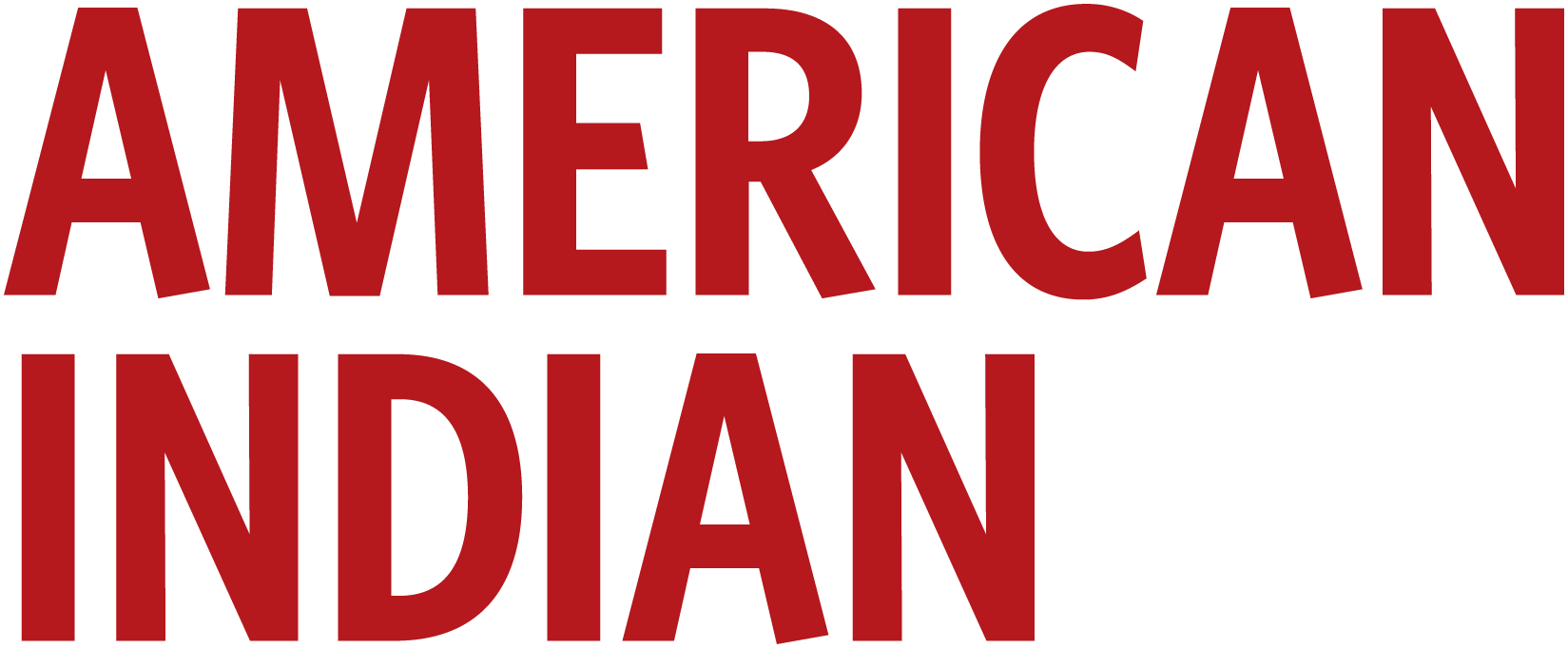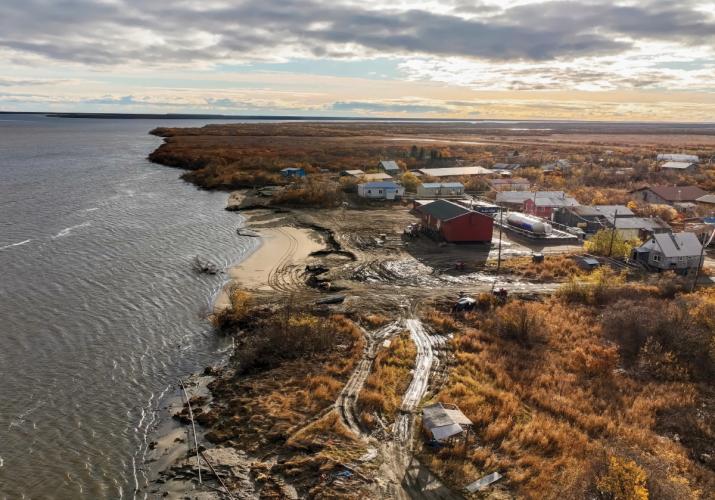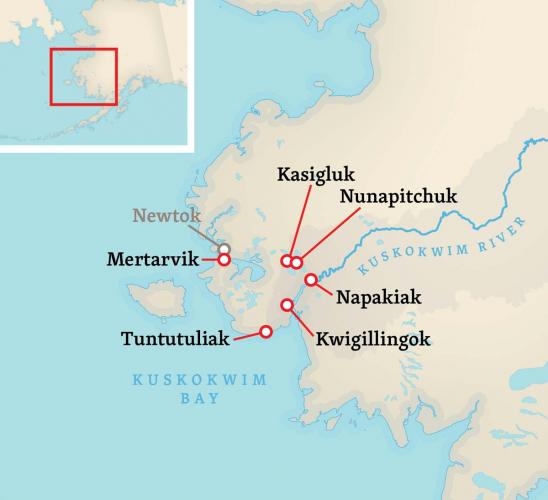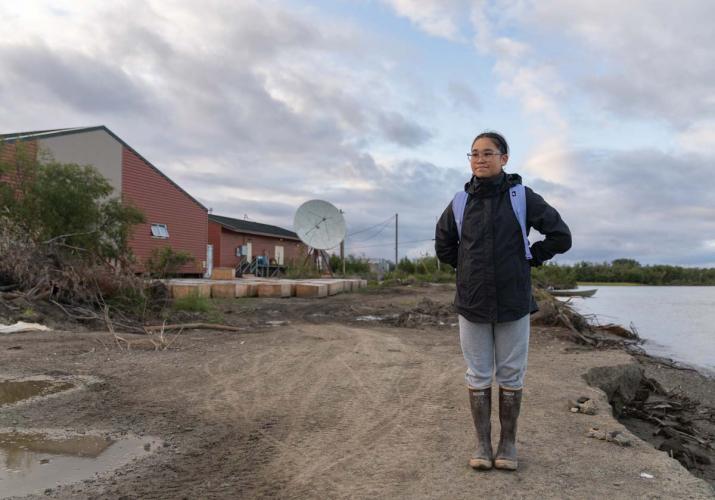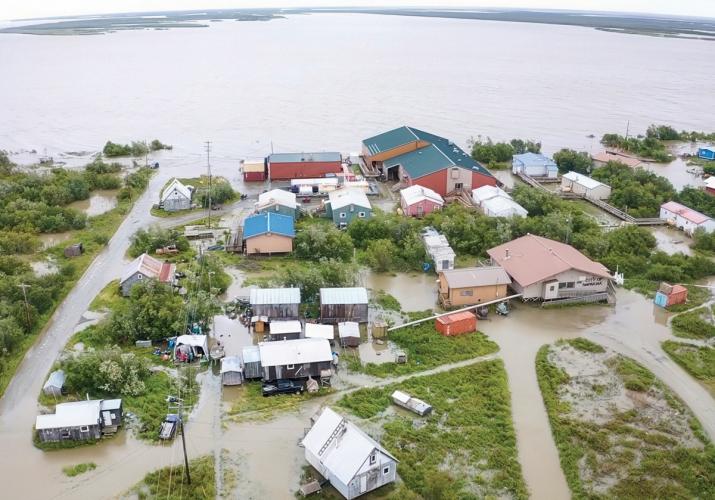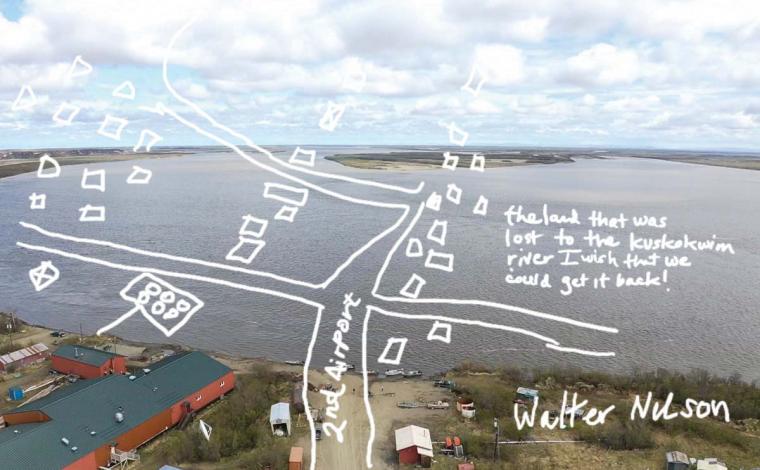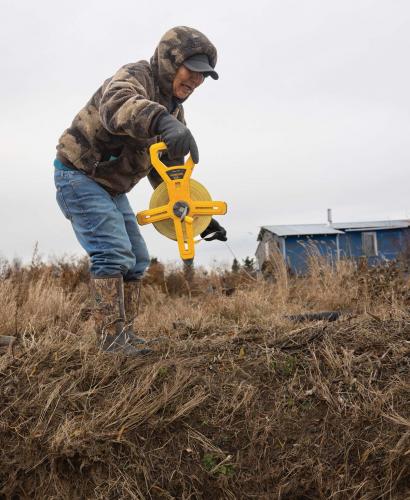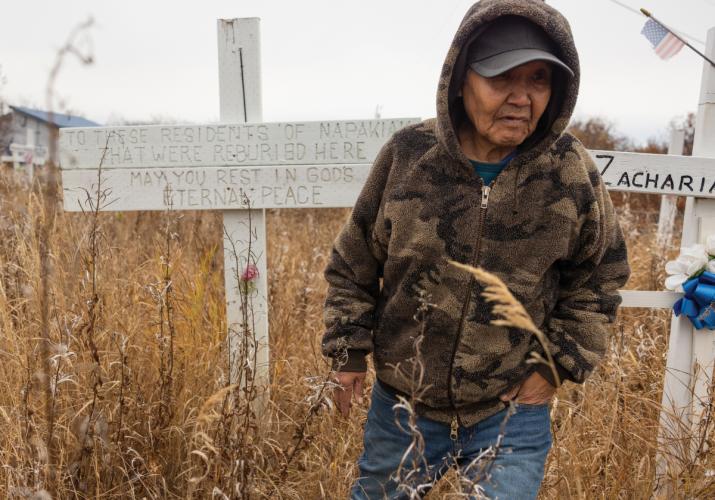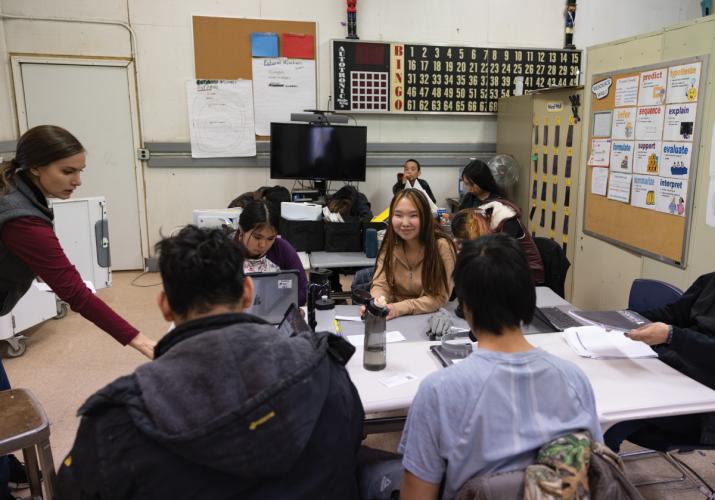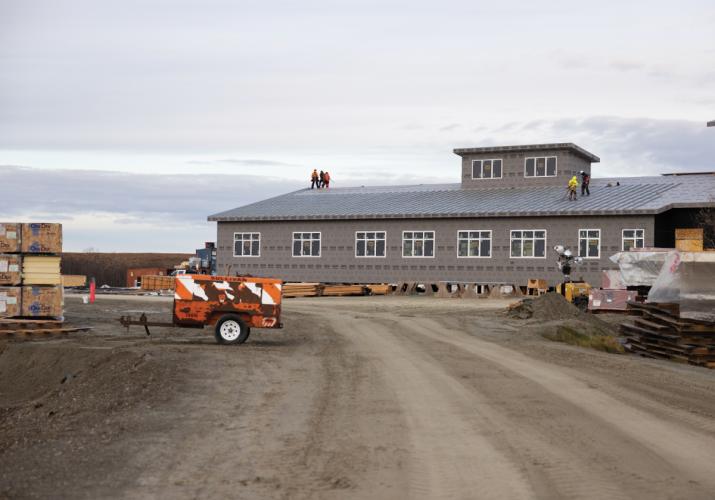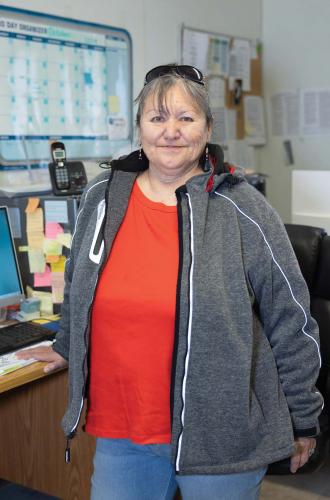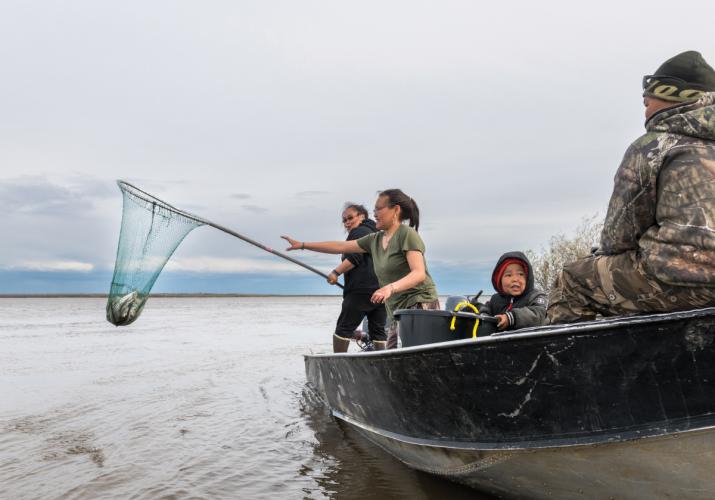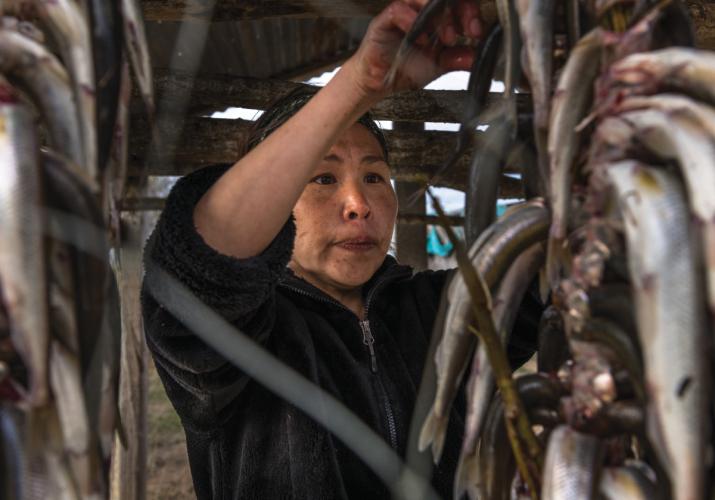On a brisk day this past October, Ralph Nelson and Tom Andrew departed the town of Bethel in an 18-foot skiff loaded with motor oil, gas and groceries for their Yup’ik village of Napakiak in southwest Alaska. On their 10-mile journey over the slate-colored waters of the Kuskokwim River—the ninth longest river in the United States—they passed two other Alaska Native villages before cruising across the Johnson Slough that borders much of the land on which their community sits. The wide, encroaching Kuskokwim River runs along its eastern shore, completing the ring of water around this slip of land.
Nelson and Andrew, Yup’ik villagers who work for their small city of about 350 people, came ashore on a dark brown sand beach below a 4-foot ledge of scalloped earth. On top of this bank was a flattened track of land where Napakiak’s red-painted school once stood. Its demolition had been completed just a month earlier. As river erosion increased in recent years, its students were moved to temporary buildings and the school—too big to be relocated—was taken down at a cost of more than $8 million.
When this school’s construction was completed in 1984, the village’s land extended over a half-mile further out into the river. On this were dirt roads, homes, water wells and an airfield—all of which have been relocated further west on this now 4.7 square mile island. Natural erosion, rapidly accelerated by climate change, continues to eat away at the shore. Other climate change–linked problems such as more frequent and intense storms and wildfires as well as thawing permafrost also threaten the hunting, fishing, trapping and harvesting Alaska Native peoples depend upon to survive. Although first listed as a village in the 1880 U.S. Census, Napakiak has been an important seasonal fish camp for local Yup’ik people for thousands of years.
In addition to the Kuskokwim River eroding its land, Napakiak has been hit by violent weather, including Typhoon Merbok in 2022 and another severe storm in August 2024 that caused extensive flooding throughout the community. However, Napakiak is one of only a few Alaska Native communities that have received tens of millions of dollars in government grants that are enabling them to rebuild or move to safer ground. By the end of 2027, many of Napakiak’s buildings will have been relocated, or like its new school, reconstructed a few miles away from the encroaching river.
Sinking Alaska
Almost half of Alaska’s more than 180,000 Native people live in about 200 rural villages similar to Napakiak. Of these, 144 face some degree of damage from erosion due to loss of sea ice, flooding from storms and degradation of permafrost, the frozen ground that covers 85 percent of Alaska. While releasing vast amounts of trapped methane—a greenhouse gas far more potent in warming the atmosphere than carbon dioxide—the sinking permafrost is also undermining the stability of water pipes, airstrips and the foundations of buildings and other infrastructure.
Within the 75,000-square-mile Yukon-Kuskokwim Delta (YK Delta) are 56 villages and Bethel, a hub city with a population of almost 6,400 people (65 percent of whom are Indigenous) that has a regional hospital and airport. Of these villages, 47 are considered “at risk” and six, including Napakiak, are at “high risk” for damages from encroaching water. Strategies to respond include “protection in place” by elevating buildings and adding raised banks and seawalls to strengthen shorelines, “managed retreat” of portions of a community to higher or more stable ground (which is what’s taking place in Napakiak), or complete relocation. Yet obtaining the millions of dollars needed to do any of these options with federal, state, tribal and philanthropic funds remains a constant challenge.
The 1988 Stafford Act authorizes the FEMA emergency response program that to date has spent $350 billion federal dollars to help communities struck by sudden disasters such as hurricanes, tornados and wildfires. However, this legislation is not structured to respond to the kind of slow-moving disasters facing Alaska Native peoples.
A Jauary 2024 “Unmet Needs” report by the Alaska Native Tribal Health Consortium (ANTHC) based in Anchorage suggests a wide range of ways to improve federal and state support for Native village–led efforts. That report closely aligns with a 2022 U.S. Government Accountability Office Report that called for the U.S. Congress to establish a coordinating entity to assist Native villages facing environmental threats. It and ANTHC also identify limitations to many existing programs, such as requiring villages to contribute a 10 percent matching fund for multimillion-dollar investments that many impoverished communities cannot afford.
About 90 miles downriver from Napakiak toward the Bering Sea, the people of the similarly sized town of Newtok recently completed a 20-year process of relocating their entire village to higher ground 9 miles away and renamed it Mertarvik (which in Yup’ik translates to “getting water from the spring”). Although this has always been Yup’ik land, as it is now also part of a U.S. Fish and Wildlife refuge, the U.S. government took eight years just to authorize them to build on the new site. In the tundra village of Nunapitchuk more than 20 miles northwest of Napakiak, some parents now warn children not to play off of the wooden boardwalks that connect buildings for fear they might sink and drown in the marsh that was until recently frozen ground or permafrost. This community may be forced to relocate.
A Shrinking Island
In frigid 40-knot winds, Ralph Nelson’s brother and Community Planner Walter Nelson (Yup’ik) used a large tape to measure the shoreline’s rate of erosion. This was his second measurement since October 1, and just 10 days later, he estimated another foot of the river’s waterfront was gone. “In 2023, we lost nearly 100 feet of ground,” he said. “Still, we’re lucky to be on an island, not tundra. We’re stable for now, but I worry about sea level rise. We could still be inundated. I’d like to build a bridge to the bluff [across the river] and move the town up there, but the Army Corps of Engineers says it’s on permafrost, so not stable.” While serving as city manager in 2020, Walter helped launch a first-of-its-kind, 50-year “managed retreat” plan for the village. Today, coordinating this move to a new subdivision being built several miles to the west of the river is his full-time job.
The nearest house still standing after the community’s storms and flooding that Nelson is measuring from is a small blue plywood and tin-roofed cabin owned by his nephew, Jonathan Nelson. Not sound enough to be moved, it is scheduled to be demolished. Jonathan hopes to move into a new house in the new section of the village being built, but he doesn’t know when that might be. “I’m worried because my windbreak’s gone,” he said, pointing to uprooted red willow saplings now hanging in the river. “I already moved my fish smokehouse to my dad’s place. During the storm, the waves and water came over the bluff and under the house. I could see the currents and waves, and I had this illusion I was moving into the river. That was scary.”
At the village’s cemetery that is dotted with white, wooden crosses, Walter indicates which one marks where his mother, Annie Nelson (Yup’ik), was recently buried. At the age of 93, she was the village’s oldest resident and a popular presenter on the Yup’ik language radio show on KYUK out of Bethel. (With some 20,000 speakers, Yup’ik is the second most widely spoken Indigenous language in the United States after Navajo). Within two fenced areas are communal burial sites where older graves have been relocated from other areas where they were threatened by encroaching water. Walter pointed to a large section of a wooden deck from one of the town’s elevated buildings that had washed in during the 2024 flood and said, “Our elders found this higher area for the cemetery and the water never got here before, but look—this happened in August.”
At 86, Jacob Black is now Napakiak’s oldest Yup’ik elder. He moved to Napakiak at age 16 and is still active cutting wood and driving his four-wheel ATV (all-terrain vehicle). His small, elevated house is on the west side of town, away from the river. He said since his wife died of COVID several years ago, his hearing has not been very good, but he can read questions written on a cell phone and answer them in English. This is the language he learned at the Children’s Home orphanage his mother sent him to as a child during the mid-1940s after his father died. The Yup’ik traditionally lived in seasonal hunting and fish camps, following their food sources. But when U.S. colonialists came to Alaska, they told Alaska Native peoples that their children had to attend school year-round, so the schools became the center of more permanent villages.
Black recalled that when he was about 7 years old and at his school, “We were not allowed to speak our tongue. But when the dorm boss was not around, we’d speak our tongues. But we were from all over Alaska and had different kinds of languages, and with some kids, I’d have no idea what they were saying.” He laughed and his deeply etched eyes brightened, “So we’d translate it to English.”
Black remembered that, “When I was up in the Children’s Home, there was lots of snow all over Alaska.” He stood up from his kitchen table to indicate the depth of the snow with his hand at his chest, nose and the top of his head. “But there’s less snow every year with warmer weather, and the permafrost was pretty thick, but now it gets thinner and thinner and the erosion gets really fast. In my young days, we didn’t have the cause of this, we didn’t have big jets blowing heat up there and snowmobiles. We only had dogs [to pull sleds]. And we didn’t have big outboard [boat] engines,” he said. “Many things are changing, like today the children, some talk back and I tell them to be decent and honor your parents. I hope someday they understand who they are and where they come from. And I hope they open the new school soon so our young people can go to school happy in their own village.”
For the past several years, nearly 90 students have been learning in temporary buildings or away at state boarding schools as a larger school was being built in the new part of Napakiak a few miles to the west. The youngest students are now in a converted preschool building while elementary and high school students have to share the former bingo hall, their temporary classrooms divided by a low wall of metal book shelves.
At Annie Nelson’s home, now lived in by her descendants, Walter offered guests a lunch of grilled moose meat, smoked salmon and a desert of “akutaq,” frozen wild berries picked in the summer and often thickened to a custard with animal fat and whitefish or pike. This is followed by a therapeutic tundra tea that is also used for smudging during Native ceremonies similar to how sage is used in other Indigenous communities.
About 60 percent of Napakiak’s food and livelihood and more than 80 percent in some villages remain subsistence based. Cash earnings don’t go far where transport has to be by boat or plane and a quart of milk can run $10. Family also plays a central role in the Yup’ik’s cultural endurance. A photo shows Annie with her daughter, granddaughter, great-granddaughter and baby great-great-granddaughter, who toddled around the kitchen during lunch.
Still, access to health care remains a problem for residents in isolated villages. The only road access to Napakiak is a seasonal ice road built every winter atop the frozen Kuskokwim River. In recent years, the river is freezing later and the ice breaking up earlier in the spring so that the period the road can safely be used is shrinking.
Health practitioner Candice Nelson (Yup’ik) heads the villages’ Yuvrrvik (Urgent Care) Clinic. Last fall, she had a patient who may have had pneumonia, but the medivac plane from the Yukon-Kuskokwim Delta Regional Hospital in Bethal couldn’t fly in the high winds. Another pilot who was about to land agreed to take the patient and his mother on the typically 10-minute flight to Bethel. So instead of staying up all night monitoring a patient in distress, Nelson was free to take her youngest son to the city building that also houses the village laundry. She has four children, two teenage daughters and two younger sons. Since the village’s former school shut down, she has sent her daughters to boarding school at Mt. Edgecumbe High School in Sitka, 976 miles away.
The older daughter, Tanya, is a senior and will go on to nursing school after graduation. The younger, Breana, a junior, “loves cross-country and wrestling,” but “doesn’t know if there will be enough students in the new school interested in sports,” said her mother. “I would like her back, my big helper, and I know she longs to go hunting and fishing and trapping and logging with her dad in cold weather,” she paused. “Now [in Sitka], she just watches the animals she’d like to hunt.”
Holding on to Hope
After lunch, Walter met with Napakiak Mayor Joann Slats (Yup’ik) at the village’s office. She recalled attending the town’s first school, which was composed of three trailers that had been flown in by helicopter. The new school, scheduled to open in 2025, will be more than 20,000 square feet and include a large gym, an auditorium and multiple classrooms and labs.
Still, she worries about the rate at which things are changing. She remembered an incident from several years earlier. “We had people on the beach on a beautiful summer day and a whole chunk fell out of the middle of the beach. It was like a whirlpool,” she recalled. “Luckily, no one was right there.”
She said Napakiak began planning its response to the changing climate around that time. “The whole community—all the entities [the city, tribe and Native corporation] got together and even the church. We were putting this plan for mitigation together and a storm hit as we were meeting at the bingo hall. It wasn’t a big storm, but ANTHC and other agencies were there, tribal housing people, and when it hit, they were sold: ‘We need to fund Napakiak,’” she said grinning.
Max Neale of ANTHC was there at that meeting and agreed that his team has made Napakiak a priority. “The community there is really fantastic,” he said. “They’re a model of how community entities can work together to make change.”
Slats recalled how she was at home during the big storm in August. “My home is across from the bingo hall, and we were having lunch and just looked out and in 5 to 10 minutes our house was surrounded by water. We had to use the ATVs to get to the road, and we couldn’t get down the road, but fortunately someone had a key to the bingo hall and we stayed there for hours. About 4 inches of water got into my home and caused a lot of damage.”
The community’s bingo hall, store and city office are three more structures scheduled for relocation to the western end of the island, where gravel pads for houses along with a new road have been built. Walter Nelson also just got notice of approval of a multimillion-dollar pipe system that will link the new subdivision’s homes to the village’s freshwater wells and treated sewage lagoon. The village presently has a delivered water and hauled sewage system where city workers on ATVs with towed containers refill and empty 100-gallon-tanks for each house.
“We just have to move from the front part of town. Our plan is to have people who can operate heavy equipment and move houses, and the new generation is learning how to do this work,” said Slats. “But we’ve got to get more young people involved in this because only when the whole community works together can we have hope.” Walter Nelson agreed: “Its challenging and frustrating. But any challenge can be worked out when we help each other, and that’s what makes Napakiak so great.”
In the fall of 2024, the ANTHC was awarded a $74.9 million grant under the Biden Administration’s Inflation Reduction Act to increase technical assistance and create almost 100 new positions throughout Alaska to support tribal communities needing to address climate change. “The work we are doing is unique because we are taking a very traditional lens and also taking a very public health lens,” explained Jackie Qatalina Schaeffer (Iñupiat), the director of climate initiatives for the ANTHC. “Our food is our health, and climate will affect us very differently. The villages depend on the environmental space for their food. They can’t just go to the grocery store.
“What’s happening in Alaska with sea level rise and the Taiga [boreal] forests burning and the permafrost … it’s not a local issue, it’s a planetary issue,” Qatalina Schaeffer continued. “The Indigenous people of Alaska, we have a symbiotic relationship with nature. We have tools for adaptation because we’ve been through ice ages and climate change before. We have a history for people to learn from.”
